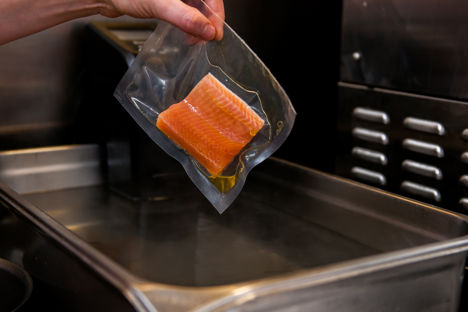
The science behind sous vide
The science behind sous vide
Sous vide is becoming more and more popular with the home cook; sales of vacuum sealers and water baths for domestic use are up fifty per cent year on year. Keen amateur cooks are realising the advantages of cooking at low temperatures and enjoying perfectly cooked food time after time. It’s easy to see the brilliant results of low cooking temperatures for meat and fish. But why is this such an effective cooking method?
The basis of sous vide cooking involves placing food in a bag and sealing it under vacuum before putting it into a water bath at a temperature below 90°C. The water is usually set just a few degrees above the ideal internal temperature of the food to be cooked. This means the food cannot overcook unlike traditional cooking methods, where the temperature of the oven can be up to 200°C (even though the ideal internal temperature of the food could be nearer 60°C).
Meat is made up of roughly seventy-five per cent water, twenty per cent protein and three to five per cent fat. When meat is heated, the proteins begin to become ‘denatured’, which means they break down. The fibres of the meat are made up of long strands of muscle bundled together; in between this tissue are more fibres (myosin and actin to be precise), and these hold the water in place within the meat. There’s also collagen, a connective tissue.
In its raw state, red meat is difficult to chew and digest. However, if you apply a little heat, things begin to change. Firstly, at temperatures above 40°C, the muscle fibres begin to contract and the meat begins to cook. A perfect medium-rare steak must reach a core temperature of 55°C to retain its characteristic pink centre. The myosin and actin also begin to shrink when heated, but if the meat goes above 65°C these fibres shrink too much and begin to expel moisture, resulting in dry meat. The fat in the meat melts when heated, which lubricates the meat and gives it the wonderful mouthfeel associated with good quality produce.
Collagens are the main reason that meat is considered tough; the older an animal is or the harder the muscle has worked, the more collagens in the meat. At 55°C, collagen is broken down and becomes gelatine, the soft oozy substance that brings body to stews and sauces. Cooking at low temperatures for long periods of time allows these collagens to break down without overcooking the meat, therefore allowing us to serve cuts that are normally considered 'tough' as pink steaks. These cuts not only have more flavour; they are also considerably cheaper than prime cuts such as sirloin or fillet.
When cooking a piece of meat sous vide, it is essentially being poached at a low temperature and the browned, crusty surface of the meat that we all love does not appear. This browning is known as the Maillard reaction and only happens at high temperatures. The Maillard reaction is what gives meat its characteristic flavour; when it is exposed to high temperatures it forms a crust. The way to achieve this with sous vide meat is to quickly pan sear or blowtorch it after the cooking process.
The collagens of fish break down at much lower temperatures, between 46-49°C. This gives the fish its familiar flaky texture, although the consistency of the flesh is dramatically different than when cooked in a hot pan or the oven. There are many health benefits from cooking fish at low temperatures; for example, nutrients that would be normally be destroyed are kept intact.
Taking all of these things into consideration, it’s easy to see why meat and fish benefits so much from sous vide cooking. The meat never reaches a high enough temperature for the moisture to be expelled, which results in a bigger, juicer end result. Cook two steaks side by side – one in the oven and one sous vide – and you will see a remarkable difference in size. After all, water baths are twenty-three times more effective at conducting heat than any oven.

